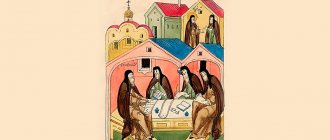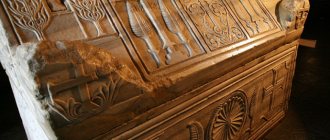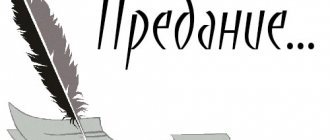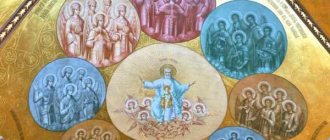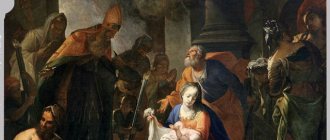On all icons of Jesus Christ, the Mother of God and saints, a luminous disk is depicted around their heads. We know that this radiance is called a halo, but we have difficulty explaining what it is. What is a halo above your head? What is it for? Can it appear in humans? Let's sort it out in order.
Christianity
Borrowed from pagan images of sun gods or rulers, especially from the iconography of Mithraism, which was supplanted by Christianity in the Roman Empire.
Calixta appears in the Roman catacombs from the 2nd century. as the crowning of the head of Christ, later Mary and the angels are also distinguished in this way. It was not widely depicted until the 4th century, when it became a symbol of the four evangelists.
Means holiness; saint; Divine origin and holiness of the Trinity, Holy Family, angels.
Typically, stylized halos are used in the form of a shining hoop or circle.
The cross halo points to Christ. / On canonical icons, the Savior’s halo necessarily contains an inscribed cross.
In Byzantine art, Satan was sometimes depicted with a halo, signifying an emission of power.
The radiance around the head is a sign in the form of a disk or light rays as a symbol of spiritual glory, depicted through painting. In contrast to the N. of the Mother of God and the saints, which serves as a general sign of holiness, inside the N. above the head of Jesus Christ a Cross is drawn in straight lines, inside the sleeves of which there are the letters o, w, n, which make up the Greek word “existent,” with which God called Himself to Moses from depths of the Burning Bush (Ex. 3:14). N. Jesus Christ with the designation of the lines of the Cross is usually called the “baptized halo.” Inside the circle of N. above the head of the Savior Good Silence, lines of an eight-pointed star are introduced: this is a symbol of the Lord of Hosts, with whom He is depicted in the New Testament Trinity (non-canonical iconography). Since the 18th century in Russian iconography, the Lord of Hosts is sometimes depicted in a triangular N. or N. in the form of two closed triangles forming a six-pointed star. On top of the N. on the icon is often fixed a repetition of it, made of metal, sometimes of fabric, covered with embroidery made of metal threads or of carved gilded (on gesso) wood: such decorations are called crowns.
About halos
Priest Pavel Florensky once remarked that everything mysterious is simple.
You are fully convinced of this by studying the iconography of the halo.
And indeed, iconographically, the halo seems to be the simplest form element of the icon. But in terms of the content contained in it, the halo is one of the most rich and complex.
Iconology did not ignore him either. However, little place was given to him in theological and art historical works. The most representative work in terms of volume was written back in the 19th century and has now been forgotten.[1]
Since then, many events have happened, and the main thing for us in this matter is the discovery of icons and frescoes from records, which has unfolded since the beginning of the 20th century, which significantly influenced iconology and increased it. But in the works of modern times, halos are spoken about either in a very general way or one-sidedly.
Therefore, it makes sense to turn to the iconology of the halo.
Let's start with the word itself. It came into our speech through the German language in the 19th century. The German “nimbus”, meaning “radiance, corolla”, arose on the basis of the Latin “nimbus” - “fog, cloud” (in which, according to the ancients, “the gods descend to earth”[2]).
From this we can understand that what is initially meant is the content of the halo.
In ancient times, Iranian-speaking peoples developed a ritual of thanking God for the mercy bestowed. In the life process of this ritual, such a phenomenon as a supernatural halo of fire and light was formed - “khvarna”, a term translated as “glory”, this halo was associated only with a hierarchically high person - the king. The etymology of the Indo-European root reg, which underlies many names of kings, speaks of it in the meaning of “light”.
Let us remember the appeal to the prince during the times of Kievan Rus: “One brother, one bright light, you, Igor!” [3] “They cried out to the brothers and squad: “My bright lights, why have you dimmed?” [4]; and the expression “Your Grace,” addressed to high-ranking persons, existed until the significant year 1917.
In the Old Testament we repeatedly encounter the image of the glory of God (kabod). And when Moses came down from Sinai with the tablets, “his face began to shine with rays because God spoke to him” (Ex. 34:29).
The Indo-Iranian synonym “gold = sun = fire” is also fixed in the ancient culture of Greece. And not only in Greece, but also in the cultures of the lands associated with it. Halos have been known here since the Hellenistic era.
Already the ancients understood that the face is a manifested “portrait” of the soul. The head is the highest - even literally, purely physically and hierarchically - part of the body. This, in our opinion, is the reason for placing the solar disk, and then the halo behind or around the head.
The fact that the pagans knew the halo is, of course, nothing surprising. The temple of church culture was built from the best materials that were available at that time. On the “crests of the advanced waves of Truth” (Fr. Pavel Florensky), knowledge about halos came to the pagans.
The churching of this knowledge was a completely logical act. This explains the appearance of the halo in Christian art (from the 4th century in images of Christ, from the 5th century in images of the apostles, and then saints). On the contrary, if there were no halo as a hierarchically significant and weighty symbol, and hence transformed into a measure and a module of composition, this art would inevitably lose its harmony and depth.
In ancient times, halos in Rus' were called “circles”; since the 19th century. - crowns. There was both logic and error in this. But first, about the word: st.-slav. crown (Greek stefanos; significant: the name of the very first Christian martyr is Stefan!), so, crown comes from Russian. veins
“wreath”, familiar to the Slavs since pre-Christian times.
It is no coincidence, apparently, that the “crown” is known in Russian as a decorative headdress, like a wooden or leather hoop that decorates a woman’s hairstyle, like one row of logs in a log house...
From the Gospel we know about the crown of thorns
, worn by Jesus Christ (hence the expression and concept of “receiving the crown of martyrdom”). Here the crown is not just an instrument of torture, but an ambiguous symbol and a practical matter that received further life in Christianity. Crowns are also “a necessary accessory to the sacrament of Marriage, which is why the marriage itself is called a wedding.”[5]
It is possible that the image of floral patterns in halos is, on the one hand, a tribute to the memory of marriage crowns, which in the ancient Church were made from tree branches and flowers, and on the other hand, a genetic memory of ritual pre-Christian wreaths, reinterpreted in a Christian way, although the latter is less likely .
The early Christians loved flowers, as Minucius Felix spoke about in Octavia.[6] But there was a church-going attitude towards the “gifts of flora”. Flower crowns merged in their minds with martyr crowns.
“The spiritual symbolic meaning of crowns in the sacrament of Marriage,” according to the explanation of St. John Chrysostom, - is to signify the victory won by chastity <...>. Another meaning is indicated by the very sequence of the wedding in the words: “Lord our God, crown me with glory and honor”[7]. Please note: “glory and honor”
, that is, the presence of the theme of glory in the crowns is evident. This is partly how the Greeks understood the halo.
It's time to understand the terms. The word “crown”, understood as “halo”, indicates its application from the outside (crown - wreath - headdress - hoop, etc.). Which looks extremely inaccurate in the internal connections between the halo and the image. L.A. also points to this. Uspensky: “The point is not to place a crown over the head of a saint, as in Catholic images, where this crown is a kind of crown of light, that is, applied from the outside, but to point out the radiance of his face.”[8] However, we cannot agree with Leonid Aleksandrovich on two points:
1) if the task was only to “indicate the radiance” of the face, then in this case a halo is not needed - it would be enough to depict the radiance like golden, sun-like rays, as Catholics often did;
2) we are generally against the use of the term “crown” in relation to the art of Orthodoxy, because we believe that it came into use due to its external resemblance to the indicated crown-objects, and does not express the essence contained in this concept; this term most accurately refers to the Western Christian culture that followed the 11th century, or at least to the period of Eastern Christian culture when it was influenced by the Western one.
In the logical chain leading into the semantic depth of the halo, as we said, another symbol is discovered - “cloud”. In the Orthodox worldview, it means the mystery of the Divine presence. The cloud reveals God and at the same time covers Him. Note that the etymology of the word “cloud” is cer.-slav. cloud - is connected in some sources with the word “shell” and follows from “about-wolf” from “dragging, dragging”, in others - with the lost “envelop”, from where the Old Slav. “cloud” – “surround, dress.”
There are several types of halo in Orthodox painting. Most often - and most often in the most outstanding monuments, especially monumental art - with a dark outline of its golden part. This outline could be different, but mostly in the form of one thick line or two thin, parallel ones;
sometimes they are just a count. In both cases, a narrow strip was drawn - a light outline - from the outer edge of the halo, approximately the width of a dark white one, but often the same color as the inner part of the halo. This iconography is the most common, and it seems to us the most correct in paracanonical terms. That's what its content says. Let's first pay attention to the dark outline. Since its presence in the overwhelming majority of monuments is obligatory, the conclusion suggests itself about a certain restrictive function of the outline: it is something like a “frame” for the light coming from the saint. We are talking here, of course, about spiritual light - about Light, which, according to Dionysius the Areopagite, “comes from goodness and is an image of goodness.”
Of the modern authors, Archimandrite Raphael (Karelin) thinks interestingly about light. In his homily on the Transfiguration of the Lord, he clarifies: “The Orthodox Church teaches that there are three types of light.
The first type is sensual. Created light, light of physical energies, measurable and characterizable.
The second is the intellectual, inherent in man, spiritual, also created light. This is the light of judgments and ideas, the light of imagination and fantasies. The light of poets and artists, scientists and philosophers. The semi-pagan world usually admires spiritual light. This light can be intense and bright, leading a person into a state of intellectual ecstasy. But spiritual light belongs to the earth. Spiritual realms are inaccessible to him.
The third type of light is uncreated, Divine, the revelation of Divine Beauty on earth and the manifestation of eternity in time. This light shone in the deserts of Egypt and Palestine, in the caves of Gareji and Betlemi (ancient Georgian monasteries), it is embodied in the words of the Holy Scriptures, in church liturgy and Orthodox icons.”[9]
Areopagite certainly means this third
a type of light, the radiance of which imparts good to all rational beings in a measure corresponding to their perceptive abilities, “and then increases it, expelling ignorance and delusion from the soul. This light exceeds all intelligent beings above the world, it is “the first light and the superlight.”[10]
In Western Christian painting, especially the Renaissance, such a restrictive outline is actually a halo, or, as we said, more precisely, a “crown”, “crown”. And the halo itself is no longer a symbol, but only a sign of holiness. There is a clear solution here. Look at Lorenzo Lotto’s painting “The Betrothal of St. Catherine and Saints Jerome, Anthony the Abbot, George, Sebastian, Nicholas of Barria,” and you will see instead of halos just golden hoops with reflections of external physical light. And this is not at all about Lorenzo Lotto. We find the same “hoops” in Giovanni Bellini in his “Altar of San Giobbe”, and in Lorenzo Costa in his “St. Sebastian”, and by Raphael in “The Holy Family” (1506), and by Leonardo da Vinci in “The Benois Madonna”, and by many, many other masters. And this issue is not limited only to Italians; a similar solution to the halo is found, for example, in the Dutchman Rogier Van Der Weyden (“Lamentation of Christ”) and the Frenchman Georges de Latour (“St. Sebastian”). Here the essence of the matter is not in the national, but in the Catholic interpretation.
The halo in the Orthodox icon, while remaining a symbol of holiness, is also a form that reveals the Divine nature of superlight. “Glory to You, who showed us the light!” - exclaims the priest in the last part of Matins. A saint in Christianity acts as a direct witness to the truth, understood precisely as light. But here the meaning of the halo, of course, is not limited to what has been said. The light outline from the outer edge of the halo is a kind of opposition to the dark one: if the latter is the Hidden shell, performing a hiding function (it is apophatic theology), then the first is the key, the REVELATION, the opportunity for the praying person to see the Light while still on earth; in this case it plays the role of a revealing function (cataphatic theology). Hence the white color of the outline, that is, symbolically consubstantial with gold, but different in substance.
But that doesn’t say everything. Clarifications needed. Gold itself does not emit light, but only reflects it from a real source; so the light of a saint by nature does not belong to him personally, but to God, and shines in the saints, like the sun in gold; “The righteous will shine like the sun,” according to the word of the Gospel (Matthew 13:43), “for they will become by grace what God is by nature”[11], writes V.N. Lossky, that is, we are talking about a given good, a gift - “good + dati” - and not about some kind of “self-flash”, “spontaneous combustion” of light in a person. The feat of holiness is a voluntary renunciation of selfhood, a struggle with it. When Rev. Seraphim of Sarov shone with this light of grace before N.A. Motovilov, what did he pray for the day before? - "God! Make him worthy to see clearly and physically with his eyes the descent of Your Spirit, with which You honor Your servants when You deign to appear in the light of Your magnificent glory!”
The symbolic meaning of the transcendence of superlight comes into opposition, on the one hand, to the real sparkling light of the golden halo, on the other, to its pictorial solution as a material plane. Pay attention to the paintings of the Assumption Cathedral in Vladimir, made by Rev. Andrey Rublev, and especially on the composition “The Last Judgment”. The halo here is a powerful material means in constructing space; The halos freely overlap the faces and figures, and, in turn, are also overlapped by the spread hands of the Angels. In the mosaic of the Church of St. Demetrius in Thessaloniki, drapes hang on the halos of the ktitors.
The halo and mandorla, however, are mysteriously transcendental details in the icon. This is, perhaps, such a riddle and secret, the solution of which was supposed to be found only at the supersensible level, when a person acquires the ability to see the world of “re-existence”. Here all the schemes of narrow rationalism burst like soap bubbles. “It is true that the meaning proposed in a cultural symbol is transparent and generally valid, namely to the extent that it is the “ meaning”
“, that is, something within itself that is transparent and universally significant, but it is equally true that it is also “mysterious,” namely, to the extent that it is objectively given - given - enigmatic to our consciousness from the outside by authorities independent of the latter. This hidden-in-itself clarity is the essence of the symbol.”[12]
But if the halo is a riddle, mystery, unknown, then we again encounter an antinomian construction: opposition to the very semantic side of the subject, that is, the mystery-unknown is balanced by the known appearance of the saint.
Hence the halo is not only Light, but also the depicted essence, that is, a phenomenon both visual and conceptual. And on a conceptual level, it rivals the visual in importance. If, as we have seen, in Western Christian art the crown is not even a conventional, but an agreed sign of holiness, then the halo in Eastern Christian art is the very graphic expression of the essence of what is depicted. This, apparently, explains that the construction of the icon began precisely from the place where the halo was chosen on the plane of the icon. And “the halo of the main figure was placed at the vertex of an equilateral triangle with a side equal to the width of the icon”[13].
In other words, the halo (and also the mandorla) was accepted by the icon painter as the main compositional element. Its radius served as a measure of the height of the human figure. Moreover, the size of the halo was even associated with the size of the temple: the radius of the apostolic halos from the “Last Judgment” in the Demetrievsky Cathedral and “The Savior in Power”, which is in the Assumption Cathedral (both in Vladimir), are equal to 1/100 of the length of the cathedral along the central axis.
The halo is built in three parts, like the temple as a whole: light outline - dark outline - inner part = vestibule - ship - altar.
The thought naturally suggests itself that the isographers give the halo a universal meaning. Placing a smaller space within a larger one can probably be considered a rather traditional and typical technique used in the practice of church art.
Such an understanding of the corolla in Catholicism is simply unthinkable, although the Byzantine influence here lasted for a very long time. And Cimabue, and to a sufficient extent Giotto, Taddes Gaddi, even Simone Martini and Pietro Lorenzetti, and especially Duccio, do not yet have any aureole; They depict, however, not a Byzantine one, but a halo, and, moreover, for a long time, it did not know the angle. However, due to the evolution of views, a purely material and straightforward understanding of it appeared. From here, with the turn of the head of the person depicted, the halo also turned, turning from a circle into an ellipse. And when the perspective is emancipated and becomes a generally accepted means of expression, the transformation of the halo into a crown begins. At first it is a translucent disk, but clear at the edges[14], and then it turns into a corolla hoop, with a tendency towards a decrease in its thickness. And as a completion, the “crown” of this process is the image of saints and without a crown at all[15].
If the halo, when viewed from the back, was nevertheless transferred to the background and placed as if in front of the face, then the halo turned into a kind of kokoshnik, and the image turned out to be unconvincing; It is probably no coincidence that Giotto himself no longer resorted to such a technique.
Both the hoop and the disc are often left
behind
and placed
above
the head. The reasons for this movement of the aureole, one must think, lie in the fact that the fascination with the foreshortening of the human figure led to the display of the saint’s head from the occipital and parietal parts. This made the use of the halo impossible. Judge for yourself: in the first case, he would simply cover his head, and then instead of a head he would get a circle (Giotto’s option is a dead end, since it does not solve anything); in the second case - when viewed from above - the halo would turn into only a line and turn out to be practically invisible. Thus, it became a plastically inconvenient detail, and in a pictorial sense it came into insoluble conflict with the naturalized image. And was replaced with a whisk. But the lack of a canon and the internal reasons of Catholicism, in the end, made it possible to exclude the whisk from use. The erosion of the ontological foundations of church art opened the way to its secularization. Which is exactly what happened. And the fastest among Catholics.
Let's return to the Byzantine halo. In Orthodoxy, at least until modern times, the halo knows no angle at all. This is the law. There are simply no examples to the contrary here. Why?! The fact is that the circle of the halo was understood by the icon painter as a designation of eternity, and, let us emphasize, in the mind of the artist a very stable identity “circle = eternity” arises. And the ancient term “circle” convincingly confirms this. Any angle of the halo will no longer be an ideal circle and, therefore, the named identity is destroyed.
Note that a round halo is also a sign of the absence of time, but, having changed in shape, it can also be a sign indicating time. The latter is confirmed by the existence of a quadrangular halo. We see it on the mosaics of the Church of St. Demetrius in Thessaloniki (VII century): “St. Demetrius with Bishop John and Eparch Leonty” and “St. Demetrius with an unknown deacon.” According to L.A. Uspensky, it meant that the person was depicted during his lifetime. And there is, of course, a backstory here. Even the ancient author Varro spoke about the sculptures of Polykleitos as “square” (guadrata). And he was not being ironic. To the ancient Greek this sounded like praise. The expression “square man” appears repeatedly in Aristotle. In his treatise “Rhetoric” he notes: “It is a metaphor to call a good (agathos) person quadrangular.” In Plato’s “Protator” we read: “Indeed, it is difficult to make a person good, perfect
in every way". A.F. Losev translates this Platonic term “perfect” as “quadrangular in arms, legs and mind”[16]. In the Christian consciousness, the number “4” is firmly perceived as a symbol of the material world: the world has four cardinal directions, four seasons, it consists of four elements. Therefore, the square is given an exclusively earthly meaning.
According to a tradition inherited from Ancient Greece, the element of earth is symbolized by a cube, and the element of fire by a ball. On a plane, a cube and a ball are depicted in projection as a square and a circle. Hence, halos are often represented in high relief in the form of a golden sphere around the head (see the Pskov icon “Archangel Gabriel” from the State Russian Museum). And even more often in the icons of modern times, dressed in luxurious “robes,” halos were made into spheres.
It turns out an interesting chain: Au (Latin Aurum - gold) - aureolus (halo) - aura - halo. Apparently, the halo was sometimes perceived as a kind of aura, if all occult accessories were excluded from it.
So, we come to the conclusion that the quadrangular halo in Byzantine iconography testified, first of all, to man’s earthly existence.
But the symbolism of this halo is also not limited to just one meaning. Otherwise the symbol would turn into a sign.
This halo was depicted with a dark outline drawn in the upper part in the form of a horizontal stripe. Here she plays a slightly different role. Firstly, the horizontal line cuts off the square formed around the head in the halo; the square here is also a kind of synonym for the circle, as its first phase, if, according to one of the mathematical definitions, a circle is considered a polygon with an infinite number of equal sides. Secondly, the part remaining above the square (here it seems to serve as a light outline) is the formation of a vertical rectangle, that is, a figure directed upward. And the delimited area is the first step in this ascent that has begun. It is no coincidence that the icon itself has a canonical rectangular format. It is also no coincidence that the veil behind the ktitors hangs over the halos only in a delimited part: in other words, the veil as a sign of the guardianship and approval of the ktitors comes into contact precisely with the stage of a person’s spiritual ascent - “seek the things that are above, where Christ sits on the right hand of God” (Col. 3 : 1). But the principle of artistic opposition also dictates the material solution: the drapery (cover) hangs on a specific plane (halo). A rectangular halo in Orthodox art is extremely rare. This is obviously due to the fact that it was not very often that people were depicted in temples during their lifetime. And if the ktitors were depicted, it is difficult to imagine them demanding a halo, even a rectangular one; and hence its iconography had little theological support, which determined the smaller information capacity compared to the round halo.
Now let's focus on color symbolism. The color of the round and rectangular halos was made different: if the first, as a rule, was gold or a color simulating gold, then the second was white. In terms of semantic meanings, this looks specifically conscious: unchanged eternal gold - and - sterile, luminous whiteness, akin to the Divine Tabor light. That is, the spiritual closeness was preserved, but the difference in their reality existence.
There are examples of red, blue, green, blue-green, white, orange-red, orange halos.
In each case, the icon painter resorted to interpretation based on the symbolism of these colors themselves.
Particular attention should be paid to the black halo. A Novgorod icon painter of the 14th century, who worked in the Church of Fyodor Stratilates on the Stream, in the wall painting “Eucharist” depicts Judas with him[17]. Because, on the one hand, Judas is still a disciple of Christ, who has not finally committed his betrayal (hence the halo), on the other hand, the “prince of this world” has already entered Judas, and instead of the former grace, the darkness of hell now reigns. For ancient Russian painting, this is an unusual approach, both in the solution of the “Eucharist” composition itself, and in the interpretation of the halo.
The halo of Christ himself remained unanalyzed. A lot, perhaps everything basic, that was said earlier regarding the golden halo is applicable here. The only difference is that we must remember Christ as the source of Light and Life. But let’s add two more questions: 1) what does the cross on the halo mean? and 2) what does the inscription on the halo cross mean? For it is only these two features that, in fact, distinguish the iconography of Christ’s halo from the halos of saints.
To answer the first question, we should look at what place the cross generally occupies in Christianity. The Cross was given a universal meaning, and the Cross was and is understood as the light of the “Face of the Lord.” It was the connection of the light of Christ with the Cross that dictated the unfocused attention to the color of the cross: in the overwhelming majority of icons it was made the same as a halo, that is, the light substances of the cross and the halo were exactly the same, while the universal meaning of the Cross was reflected in the inscription, which was applied directly to the cross: UN – Existent, Syy; which was overgrown with a considerable number of legends and myths.
Very often in Russian icons the letter “t” is placed above the letter omega.
She was the confirmation of the mentioned myths. Father Pavel Florensky observed that “rural priests, and behind them peasants, sometimes explain to children, students of parochial schools, the cruciform crown of the Savior <...> as an abbreviation: He is Our Father <...>, where from is, obviously, already an actual contraction of the word Father.”[18]
The custom of applying the inscription actually arose simultaneously with the appearance of the halo, but it was applied not on the halo itself, but nearby. Responding to the heresy of Arius, who preached about the creatureliness of Christ, for which he was condemned by the First Ecumenical Council in 325, the Church did not limit itself to developing the Creed; it was decided to write the letters alpha and omega on the sides of the image of the Savior, reminiscent of the words from the Apocalypse: “I am alpha and omega, the beginning and the end, the first and the last” (22:13). Which should be understood as an indication of the Divinity of Jesus Christ. Much later, the letters alpha and omega were replaced by the word UN, which began to be written directly in the halo. But the meaning did not change from this, since both the letters and the word served the same purpose - to indicate the consubstantiality of the Son with the Father.
Finally, it remains to figure out why the image of each crossbar was accompanied by one at the top and two at the bottom, and not one, say, on both sides. I.K. Yazykova believes, for example, that these “nine rulers” mean “9 angelic ranks, the glory of God.”[19] Perhaps Irina Konstantinovna is right. In our opinion, the point here is as follows. Firstly, these “nine lines” are precisely a cross. Moreover, it is designed to emphasize the idea of a center, the core of which is the very image of the Lord, and the “ruler” is nothing more than the direction of movement: from the center - from the inside to the outside. Secondly, the two lines below indicate the thickness of the cross, the Cross as a completely material form that has a real history-truth behind it. And at the same time, this is again the opposition of the material in form
cross
spiritual essence
of the cross and halo. There was no special rule prescribing which side to show the thickness on the vertical part of the cross. Usually it corresponded to the angle in which the head of Christ was depicted. And the use of such a technique served not to emphasize the angle, but to rhyme it.
The trapezoidal thickening of the ends of the cross, behind the dark outline, but often inside the halo, is the essence of the this-worldly penetration of the Cross, which pre-existed the world and time itself, or rather, the “scattering” of the glory of the Cross into the universe, expressed graphically.
We will not dwell on the iconography of the halo of hosts in the “Fatherland” icon: the Seventh Ecumenical Council explained the impossibility of depicting the First Hypostasis of the Holy Trinity by Her non-incarnation: only the Son was revealed and visible in the flesh; The Great Moscow Council (1666-1667) generally banned the image of God the Father. This means that the said iconography is ecclesiastically illegal.
But there are also halos of triangular, hexagonal, octagonal shapes... They are also not canonical, since they accompany those symbolic images that are prohibited or contradict the decisions of the Fifth-Sixth Ecumenical Council. This means that they are not included in the range of issues we are considering.
Now let's summarize what has been said. As a symbolic form, the halo has its pedigree both in the Old Testament culture (at the level of ideas) and in the ancient cultures of non-Christian peoples. But, once in Christian conditions, it is filled with new content and becomes the main detail (of course, after the image of the saint himself) in the icon. His status is asocial. If among the Indo-Iranian tribes the prototype of the halo - a fiery halo - is associated exclusively with the royal name, then in Christianity the halo-bearer is not a king, but a great ascetic, prayer book, martyr, regardless of his social status. Some administrative attempts were doomed: holiness is not introduced by decree, it is discovered.
In most cases, the ancient isographer tried to adhere to paracanonical provisions in the iconography of the halo, especially when it came to monumental work. Hence, in Byzantine, South Slavic, Christian-Eastern and Old Russian painting, such iconography was least subject to change throughout the Middle Ages and, despite different national cultures, remained the same type. Because she was perceived as Orthodox.
And when, under the influence of the western winds, the church art of Orthodoxy began to change its shape, then, first of all, it ceased to be canonical.
And, therefore, chaste.
[1] Stefaniel. Halo and radiant crown in works of ancient art. St. Petersburg, 1863.
[2] Shansky N.M., Ivanov V.V., Shanskaya T.V. Brief etymological dictionary of the Russian language. M., 1971. P. 292.
[3] The Word about Igor’s Campaign // Fiction of Kievan Rus of the 11th-12th centuries. P.243
[4] The story of the ruin of Ryazan by Batu // Fiction of Kievan Rus of the 11th-12th centuries. P.273.
[5] Handbook for a clergyman. T.4. P.689.
[6] Early Church Fathers. Brussels. 1988. P. 589.
[7] Handbook for a clergyman. T. 4. P. 689.
[8] Uspensky L.A. Theology of the icon of the Orthodox Church. Paris: ed. Western European Exarchate MP, 1989. P. 139.
[9] Rafail /Karelin/, archimandrite. Great Christian holidays. St. Petersburg: New City, 1997. pp. 85-86.
[10] History of aesthetic thought. T.1. M., 1985.. P. 340.
[11] Lossky V.N.. Theology of light in the teachings of St. Gregory Palamas // Journal of the Moscow Patriarchate. 1968. No. 4. P. 56.
[12] Averintsev S.S. Preliminary notes for the study of medieval aesthetics // Old Russian art. Foreign connections. P. 378.
[13] Gusev N.V.. Some techniques for constructing composition in Old Russian painting of the 11th-17th centuries // Old Russian art. Artistic culture of Novgorod. M., 1968. P. 128.
[14] See: Masaccio “Healing by Shadow”. 1426-1427 Brancacci Chapel, Church of Santa Maria del Carmine, Florence;
Mantegna: 1) “St. Sebastian". Kunsthistorisches Museum, Vienna; 2) “St. Euphemia.” Museum and National Gallery of Capodimonte, Naples.
By the way, the same “disk” instead of a halo appears in Russian icons of the 17th century (“Ilya the Prophet with the Life.” Second half of the 17th century. From the Yaroslavl Church of Elijah the Prophet).
For the sake of objectivity, let’s say that the “disc” seems to be present in the mosaic from the church of Santa Maria Maggiore (432-440 Rome). But this example only testifies to the search for the language of church art, and not to its norm.
[15] See: Pordenone “St. Sebastian, St. Roch and St. Catherine". Church of San Giovanni Elemosinario, Venice.
Francesco Francia “Madonna and Child with Saints.” 1500 Hermitage, St. Petersburg.
Roberti “Madonna and Child with Saints.” 1481 Brera Gallery, Milan.
[16] Losev A.F.. Artistic canons as a problem of style // Questions of aesthetics. Issue 6, 1964. P. 364.
[17] See: Kovaleva. V.M. Painting of the Church of Fyodor Stratilates in Novgorod. Based on materials from new discoveries of 1974-1976. // Old Russian art. Monumental painting of the XI-XVII centuries. M., 1980. P. 166.
[18] Florensky Pavel, priest. Cult, religion and culture. Theological works. Sat 17th.P.113.
[19] Yazykova I.K. Theology of the icon. M., 1995. P. 61.
What is a halo
A halo is a circle above the head of saints, which is present in all religious images. The meaning of a word may undergo slight changes in different cultures.
Thus, in Hinduism, an artistic feature is the glow of the aura of the entire body of a person or deity, and in Buddhism, the light around a person carries the meaning of internal spiritual enlightenment.
Origin of the word
The term “nimbus” translated from Latin (nimbus) means “cloud, cloud”. This word came into the Russian language from German in the 19th century. The German word "nimbus" was the name given to the ring above the head of an angel or saint.
Before they were borrowed, these symbols of holiness in Russia were called “circles,” and after that they also began to use the name “crown,” which spread under the influence of Catholicism as an image of a reward given from above.
Meaning of the concept
In religious images of Christians, the radiance surrounding the figure of a person or angel can be interpreted as a designation of inner purity (Orthodoxy) and a reward given from above (Catholicism).
Regardless of the specific meaning in which the word “halo” is used, this term has some common properties in any culture:
- holiness;
- closeness to the divine;
- manifestation of the supernatural.
In addition to the most common meaning of the word, halo is also called:
- a luminous circle near rapidly rotating objects or people opposite the sun (halo);
- an atmosphere of universal honor around a famous person.
Where did the halo come from?
Photo: Byzantinepainting.com
The halo as a graphic symbol was introduced into Orthodox iconography from the religious art of the Middle East. At the same time, Orthodox icon painters initially began to put a different religious essence into it. The radiance that they depicted around the saint’s head directly began to mean his involvement with the Almighty.
The most ancient images of Jesus with a halo above his head date back to the 4th century, when there were persecutions of Christians. Therefore, sacred images were created in the catacombs, where believers hid from the pagans who persecuted them. In those days, halos were predominantly white or blue; they could also be painted to match the background color.
The Savior's white halo is found in his images discovered in Ravenna and Rome. These are mosaics from the era of early Christianity. There are also several other options, including gold and white-gold. In those days, saints and angels were depicted with halos of various shades; in addition to the listed options, there were red, blue and green.
The essence of the halo in science
Scientists have long been able to prove to the world the existence of the human aura. In essence, this is a biofield that protects our body from external, negative energy. The aura exactly reflects our inner state. All our thoughts, feelings, spiritual and physical health are united into a single energy shell. The upper part, in particular the head, has protection in the form of a halo (halo).
The stronger a person’s aura, the easier it is for him to resist negative external factors. This may include attacks by energy vampires and other people trying to get into personal space and disrupt the internal spiritual balance. The aura can be shaped like a cocoon, an inverted mushroom, or a pear. In the first case, the person is most protected. The other two forms do not work at full strength. The energy layer covers the human body only partially, thereby exposing vulnerabilities.
All our thoughts and actions are instantly reflected in the aura. The more we work on our spiritual development, the stronger our biofield will be and the halo will be able to manifest itself.
Symbolic meaning
Photo: Petr-icons.ru
Over time, a clear idea of the symbolism of the halo has developed. Early Christian icon painters began to clearly distinguish what they meant by depicting a halo of one color or another:
- white symbolized heavenly radiance;
- golden – divine origin;
- blue personified a direct connection with Heaven;
- red was the color of the Resurrection, the sacrifice of oneself;
- green was interpreted as a symbol of eternal and never-ending life.
Over time, the halos predominantly became gold; this became a definite icon-painting tradition. However, other color solutions are still considered acceptable and canonical. Specific examples include the “Great Panagia” by Alypius of Pechersk, in which the Mother of God and the Savior are depicted with white halos. The famous icon of Tenderness turned out to be so memorable precisely because of the flaming halos above the heads of the newborn Christ and the Virgin Mary.
Nowadays, icon painters use the entire palette of visual language left to them by their predecessors from the past.
